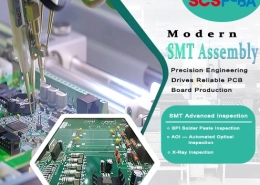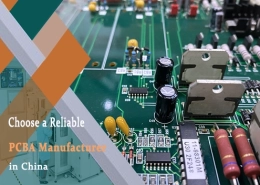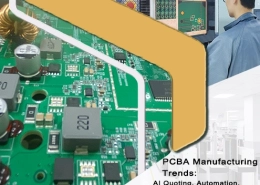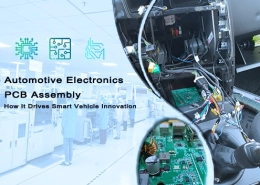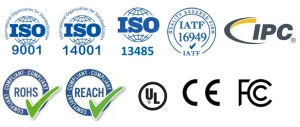9 PCBA Cooling Tips: The Key to Improving Automotive Equipment Performance
As electronic devices become increasingly popular, circuit boards, like an unbeatable line of defense, have become a key component in automotive electronics manufacturing. Their importance is becoming increasingly prominent, ensuring that automotive electronics can operate stably and efficiently.
In automotive electronic equipment, power devices are essential, but due to the increasing heat generated by high-power automotive devices, one of the main reasons is that the heat generated by the internal circuit boards is becoming more and more. Heat dissipation through the car shell cannot meet the heat dissipation needs of the equipment. Therefore, mastering a variety of circuit board heat dissipation methods and techniques and providing a reasonable PCB design solution can extend the stability and life of automotive equipment and ensure the smooth operation of automotive equipment.
1. Printed Circuit Assembly Design Scheme
Optimize the design of circuit board assembly heat dissipation function, and give priority to high temperature resistant and good performance electronics components. According to the temperature index of automobile equipment, determine the PCB assembly and manufacturing wire width and copper foil thickness; according to the size of the electronic equipment circuit board, determine the heat dissipation method, thermal conductivity width, component size, density, etc., set copper thermal strips between the PCB boards and the components, and use the copper thermal strips to transfer the energy of the components, to improve the heat dissipation and thermal conductivity. When designing the automotive PCB and assembling the function, make full use of the low-power standby mode of the chip and wake up the system only when needed, such as the display screen, communication module, etc.
2. Components Reasonable Layout
All heat sources are separated to disperse the heat and avoid local overheating. Generally, components with small heat loss are placed in the center, and PCB board components with relatively large heat loss are placed on the periphery. Dual in-line components are preferred. High-heat electronic components should also be placed in circuit board areas with good airflow, close to heat dissipation holes or fans. At the same time, attention should be paid to the distribution of the power layer. Reasonable design of the power layer can disperse the current and reduce heat.
3. Use Low-power Components
Choose low-power components to reduce heat generation from the source. For example, in-vehicle electronic devices use microcontrollers and processors with low-power modes. These devices usually have multiple energy-saving modes such as sleep and deep sleep. You can also choose low-power sensors, ADCs, DACs, and communication modules. These PCB board parts consume less power both in standby and working mode.
4. Choose PCB Circuit Board Material with Heat Dissipation
● Thick Copper PCB
Using heavy copper layer circuit board can dissipate heat more effectively, especially for high-power circuits in automotive electronics.
● Metal-based PCB
Using automotive metal-based PCB boards, such as aluminum-based circuit boards, these materials have good thermal conductivity and can significantly improve the heat dissipation effect.
● Multi-layer PCB
Using a multi-layer PCB, each layer of the circuit board has copper foil, and the heat dissipation layer is designed inside the PCB to improve the heat dissipation efficiency by increasing the heat conduction path.
● Heat Dissipation Vias
Heat dissipation vias are designed on automotive electronic pcb board production to transfer heat from the heat-generating components to the other side of the PCB board or the heat dissipation layer.
● Thermal Pads
Design a dedicated thermal pad on the automotive electronic circuit board to conduct heat to the heat sink or housing.

5. Preferentially Select High-Efficiency Heat Dissipation Materials
In automotive PCBA manufacturing, selecting materials with high thermal conductivity, such as copper or aluminum, effectively transfers heat from electronic components to heat dissipation devices. For example, using thermal conductive glue between power components and heat sinks significantly improves heat conduction efficiency. In high-power automotive electronics, thermal conductive pads can efficiently transfer heat to larger dissipation areas, ensuring the PCB circuit board operates reliably.
6.Use a Heat Sink to Enhance PCB Heat Dissipation
For high-power ICs or power components, soldering a small heat sink directly onto the element and using thermal conductive glue or thermal pads improves heat dissipation efficiency. Combining a fan and a heat sink further enhances airflow, rapidly dissipating heat and ensuring stable PCBA circuit board performance. This method is commonly used in automotive electronics PCBA manufacturing, effectively managing high-temperature environments.
7. Increase Printed Circuit Assembly Heat Dissipation Area
In automotive PCBA manufacturing, increasing the PCB copper foil area, especially around heat sources, effectively improves heat dissipation. Additionally, adding large copper pours in unused areas of the PCB board enhances heat conduction. Designing thermal vias near heat sources allows heat to transfer from one side of the component to the other side of the PCBA or a designated heat dissipation area, expanding the heat dissipation surface and improving overall PCB thermal management.
8. Real-time PCB Assembly Temperature Monitoring
In circuit board design, strategically placing temperature sensors near key components enables real-time monitoring of temperature fluctuations. By analyzing temperature data, potential PCB heat dissipation issues can be identified early, ensuring proper thermal management and preventing electronic components from overheating. This improves the reliability and longevity of PCB manufacturing and assembly.
9. Regularly Maintain Car Electronics PCBA
Use compressed air or a soft brush to regularly clean dust and dirt from automotive printed circuit assembly, such as automotive circuit board assembly for engine control units, to prevent dust accumulation and affect heat dissipation. Regularly clean dust and debris from fans and heat sinks to ensure smooth air circulation. Regularly check the condition of circuit card assembly to see if there are any discoloration, burn marks or other signs of damage, such as Vehicle Circuit Board with thermal management functions; check the condition of connectors and solder joints to ensure that there is no oxidation, looseness or breakage, such as Car electrical circuits assembly for battery management systems; check the fixation of heat sinks and heat pipes to ensure that they are firmly connected and not loose or falling off, such as vehicle box build assembly for vehicle sensor integration. At the same time, since materials such as thermal grease and thermal conductive glue will age over time, replace these materials regularly to maintain good thermal conductivity.


